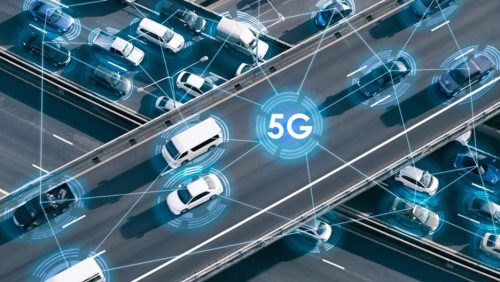
Automotive industry switches on wireless mode with the latest 5G mobile networks in self-driving vehicles. Vehicles are nowadays becoming autonomous that means no intervention of humans to drive. Is it possible? Yes, definitely. With the invention of new-age wireless technology like 5G which is much faster, reliable with low-latency response, 5G autonomous vehicles gets its way to be plied on roads sooner than ever. Automobile companies like Tesla, Volvo, Waymo, Voyage have been steering the ship with the development of independent driving technologies to be deployed in vehicles. The year 2021 is likely to witness the continuation of all trends that were bubbling even before the COVID-19. Owing to the lockdown and economic slowdown in many countries across the globe, the market for autonomous vehicles is expected to recover at a CAGR rate of 12.7% from 2021 and reach 1,191.8 billion USD by 2023.
5G technology is paving the way for autonomous driving
Sensors are one of the critical components that pave the way for driverless cars. But these need to be deployed in huge numbers which further generate bulk of data approximately 2 Petabytes of data per year as per experts’ suggestion. Now, to process such huge amount of data, even the best Wi-Fi network will require a month to transfer a week of data which is not possible without the availability of high-speed network to process data faster in case of networks like 3G or 4G. With the invention and implementation of new networking technology like 5G in self-driving vehicles, it is easier to process data from edges leading fast response time due to its low latency feature and possibility to execute tasks for enhanced location awareness. Once adopted in full-scale, it has the capability to offer hundred times more speed than previous networks like 4G with many more possibilities to work on vehicular technologies such as V2X (Vehicle-to-Everything), V2V (Vehicle-to-Vehicle) and V2I (Vehicle-to-Infrastructure) and enable different transportation use cases. To test seamless connectivity across all vehicular components – sensors (LIDAR, RADAR units), cameras, GPS, requires testing with state-of-the-art 5G test equipment for verification and validation of functions used in driverless cars. Ford, an American MNC automaker is continuously testing autonomous vehicles increasing its fleet to around 100 tested under severe weather conditions like snowy roads and entire dark regions.
Though companies are embracing 5G technology at a faster pace, it will still take some time to provide network coverage for widespread use of self-driving cars globally. It is even more critical when it comes to deploy this technology on vehicles due to technical complexities and challenges involved relating to government regulations, standards, infrastructure, driver interface and most importantly safety of humans.
There is a growing trend of private 5G network deployed in different verticals to serve their business needs. Automotive industry is no behind and is using such technology to operate cars in more secured and efficient manner. Vodafone recently agreed to build a private 5G network for Horiba Mira, an automotive engineering consultancy firm to test driverless cars at its headquarters located in Midlands.
On the other hand, chipmakers like Intel and Qualcomm are developing chips to alter autonomous cars into data centers enabling them to take more complex decisions and enhance their decision-making process in real-time.
What are the benefits of autonomous vehicles?
- Low-latency feature of 5G network makes it desirable to be embedded in connected cars with faster response time to execute.
- With 5G, edge computing can be enabled to process data from corners irrespective of the size.
- High-bandwidth allows seamless data transfer and ability to handle heavy data loads.
- Seamless 5G network connections with on-location GPS notifications.
- Real-time alerts of hazards such as snowy roads or traffic signal ahead of reaching that particular location or avoid busy routes.
- Less congestion on the roads due to avoidance of congested routes.
- Lower emissions of Carbon-dioxide (CO2) in the atmosphere and contribute to green environment.
- Reduce transportation costs (for e.g., fuel costs).
Application of automation has become a part of our day-to-day lives to ultimately save our time in doing oh so obvious regular tasks. Giving automation a more meaningful and convenient angle would be likely to sit in self-driving cars as mere passengers – using mobile networks to read headlines of the day, play online games, shopping, participate in video conferencing and many more. This certainly sounds exciting right! One of the trendiest inventions of all times, autonomous vehicles are being designed with cutting-edge technologies like 5G that will respond quickly in a more efficient manner tested under various environmental conditions and user input. A host of auto tech companies are investing heavily in autonomous R&D to lead the self-driving technology and get a slice of it once the 5G autonomous vehicles are commercialized. This next-generations car is expected to change the way we view mobility with not only just enabling transportation but also providing a sheer comfort, entertainment while uncompromising the safety of passengers and surrounding infrastructure.
Interesting Related Article: “Everything you Need to Know About what the 5G Network“

